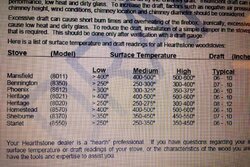I can "accurately" use my cook top/single wall pipe thermometer on top of my stove and pretty much trust the degree reading?
Yes - BUT - that is based off of your thermo being somewhat accurate to begin with. To clarify - if you have an accurate thermo - it doesn't matter if you stick it to your stove top or pipe - it will still give an accurate reading. WHAT you are reading makes the difference. Seeing 650F on a stove top - no biggie. Seeing 650F as a surface reading of your stove pipe...
 . Time for action.
. Time for action.




